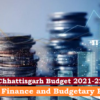
Fiscal policy means the use of taxation and public expenditure by the government for stabilization or growth of the economy. Fiscal policy of India always has two objectives, namely improving the growth performance of the economy and ensuring social justice to the people.
The fiscal policy is designed to achieve certain objectives:
- Development by effective mobilization of resources: through taxation and savings
- Reduction in inequalities of Income and Wealth: through progressive taxation and schemes
- Price Stability and Control of Inflation: by reducing fiscal deficits, introducing tax savings schemes
- Employment Generation: through concession and discount, schemes
- Balanced Regional Development: through public expenditure on grants, projects
- Reducing the Deficit in the Balance of Payment: through export incentives, import duties
- Foreign Exchange Earnings: through incentives to foreign investors
Components of Govt Budget
Article 112: There is a constitutional requirement to present before the Parliament a statement of estimated receipts and expenditures of the government in respect of every financial year.
‘Annual Financial Statement’ constitutes the main budget document comprises of the (a) Revenue Budget: consisting of Revenue Expenditure and Receipts and the (b) Capital Budget: consisting of Capital Expenditure and Receipts
Revenue Receipts:
- Divided into tax and non-tax revenues.
- Tax revenue receipts comprise of direct taxes – which fall directly on individuals (personal income tax) and firms (corporation tax), and indirect taxes like excise taxes (duties levied on goods produced within the country), customs duties (taxes imposed on goods imported into and exported out of India) and service tax. The share of direct taxes in gross tax revenue has increased from 19.1 per cent in 1990-91 to 41.3 per cent in 2003-04.
- Non-tax revenue consists of interest receipts (on account of loans by the central government which constitutes the single largest item of non-tax revenue), dividends and profits on investments made by the government, fees and other receipts for services rendered by the government. Cash grants-in-aid from foreign countries and international organisations are also included.
Revenue Expenditure:
- All those expenditures which do not result in creation of physical or financial assets. It relates to those expenses incurred for the normal functioning of the government departments and various services, interest payments on debt incurred by the government, and grants given to state governments and other parties (even though some of the grants may be meant for creation of assets).
Budget documents classify total revenue expenditure into plan and non-plan expenditure. Plan revenue expenditure relates to central Plans (the Five-Year Plans) and central assistance for State and Union Territory Plans.
- The main items of non-plan expenditure are interest payments, defence services, subsidies, salaries and pensions.
Capital Receipts:
- The main items of capital receipts are market borrowings and from Banks, loans received from foreign governments and international organisations, and recoveries of loans granted by the central government.
- Other items include small savings (Post-Office Savings Accounts, National Savings Certificates, etc), provident funds and net receipts obtained from the sale of shares in Public Sector Undertakings (PSUs).
Capital Expenditure:
- This includes expenditure on the acquisition of land, building, machinery and equipment, investment in shares, and loans and advances by the central government to state and union territory governments, PSUs and other parties.
Measures of Government Deficit
Revenue Deficit:
| Revenue deficit = Revenue expenditure – Revenue receipts |
Fiscal Deficit:
| Gross fiscal deficit = Total expenditure – (Revenue receipts + Non-debt creating capital receipts) |
- It is the difference between the government’s total expenditure and its total receipts excluding borrowing
- Examples of Non-debt creating capital receipts are recovery of loans and the proceeds from the sale of PSUs.
- The fiscal deficit will have to be financed through borrowing.
| Gross fiscal deficit = Net borrowing at home + Borrowing from RBI + Borrowing from abroad |
- Net borrowing at home includes that directly borrowed from the public through debt instruments (for example, the various small savings schemes) and indirectly from commercial banks through Statutory Liquidity Ratio (SLR).
Primary Deficit:
| Gross primary deficit = Gross fiscal deficit – net interest liabilities |
To obtain an estimate of borrowing on account of current expenditures exceeding revenues, we need to calculate it.
Government Debt (Public Debt)
Article 292: Government of India can borrow amounts specified by the Parliament from time to time.
Article 293: State Governments in India can borrow only from internal sources.
Thus the Government of India incurs both external and internal debt, while State Governments incur only internal debt.
Definition:
Public Debt: Debt contracted against the guarantee of Consolidated Fund of India (defined as Public Debt)
- Internal debt: owed to
lenders within the country.
- The government borrows by issuing the Government Bonds and T-Bills (Treasury Bills).
- Securities issued to International Financial Institutions
- Borrowing from RBI under Market Stabilization Scheme (MSS) Bonds for sterilization operations
- External debt: owed to
creditors outside the country.
- The outsider creditors can be foreign governments, International Financial Institutions such as World Bank, Asian Development Bank etc., corporate and foreign private households.
- External debt may be of several kinds such as multilateral, bilateral, IMF loans, Trade credits, External commercial borrowings etc.
- When the non-resident Indians park their funds in India, it is also a type of external debt and is called NRI deposits.
Other Liabilities: Liabilities in the Public Account (called as Other Liabilities):
- Liabilities on account of Provident Funds
- Reserve Funds and Deposits, Other Accounts, etc
- Securities issued against ‘Small Savings’: All deposits under small savings schemes are credited to the National Small Savings Fund (NSSF). The balance in the NSSF (net of withdrawals) is invested in special Government securities.
There are two interlinked aspects:
- Whether government debt is a burden
- Issue of financing the debt.
Debt is a burden:
- By borrowing, the government transfers the burden of reduced consumption on future generations. This is because it borrows by issuing bonds to the people living at present but may decide to pay off the bonds some twenty years later by raising taxes. These may be levied on the young population that has just entered the work force, whose disposable income will go down and hence consumption. Thus, national savings, it was argued, would fall.
However,
- Traditionally, it has been argued that when a government cuts taxes and runs a budget deficit, consumers respond to their after-tax income by spending more. A counter argument is that consumers are forward-looking and would increase savings now, which will fully offset the increased government dissaving so that national savings do not change. This view is called Ricardian equivalence which says that in the face of high deficits, people save more.
- It is called ‘equivalence’ because it argues that taxation and borrowing are equivalent means of financing expenditure. When the government increases spending by borrowing today, which will be repaid by taxes in the future, it will have the same impact on the economy as an increase in government expenditure that is financed by a tax increase today.
- Also, if the government invests in infrastructure, future generations may be better off, provided the return on such investments is greater than the rate of interest. The actual debt could be paid off by the growth in output. The debt should not then be considered burdensome.
Debt is inflationary:
- When government increases spending or cuts taxes, aggregate demand increases. Firms may not be able to produce higher quantities that are being demanded at the ongoing prices. Prices will, therefore, have to rise.
However,
- If there are unutilized resources, output is held back by lack of demand. A high fiscal deficit is accompanied by higher demand and greater output and, therefore, need not be inflationary.
- Government borrowing from the people reduces the savings available to the private sector. To the extent that this reduces capital formation and growth.
However,
- The economy’s flow of savings is not really fixed unless we assume that income cannot be augmented. If government deficits succeed in their goal of raising production, there will be more income and, therefore, more saving. In this case, both government and industry can borrow more.
Deficit Reduction
Government deficit can be reduced by an increase in taxes or reduction in expenditure.
- Government has been trying to increase tax revenue with greater reliance on direct taxes (indirect taxes are regressive in nature – they impact all income groups equally).
- There has also been an attempt to raise receipts through the sale of shares in PSUs.
- The major thrust has been towards reduction in government expenditure. This could be achieved through making government activities more efficient through better planning of programmes and better administration.
- The other way is to change the scope of the government by withdrawing from some of the areas where it operated before.
Trends of Public Debt
Chhattisgarh (Budget 2019-20)
Revenue deficit: Excess Rs 1,151 Crore (0.32% of GSDP)
| Year | 2016-17 | 2017-18 | 2018-19 | 2019-20 |
| Chhattisgarh | 2.1% | 1.1% | (-)2.0% | 0.32% |
Fiscal deficit: Rs 10,881 Crore (2.99% of GSDP)
| Year | 2016-17 | 2017-18 | 2018-19 | 2019-20 |
| Chhattisgarh | 1.6% | 3.3% | 3.1% | 2.99% |
Outstanding Liabilities: Accumulation of borrowings over the years, expected at 21.2% of the GSDP
| Year | 2016-17 | 2017-18 | 2018-19 | 2019-20 |
| Chhattisgarh | 16.6% | 18.2% | 18.1% | 21.2% |
All India Public Debt (2018-19)
| Public Debt External Debts | 40.6% 2.7% |
| Public Accounts | 4.7% |
| Total Liabilities | 45.4% |
| Fiscal Deficit | 3.4% |

 Home
Home Syllabus
Syllabus Contact Us
Contact Us








